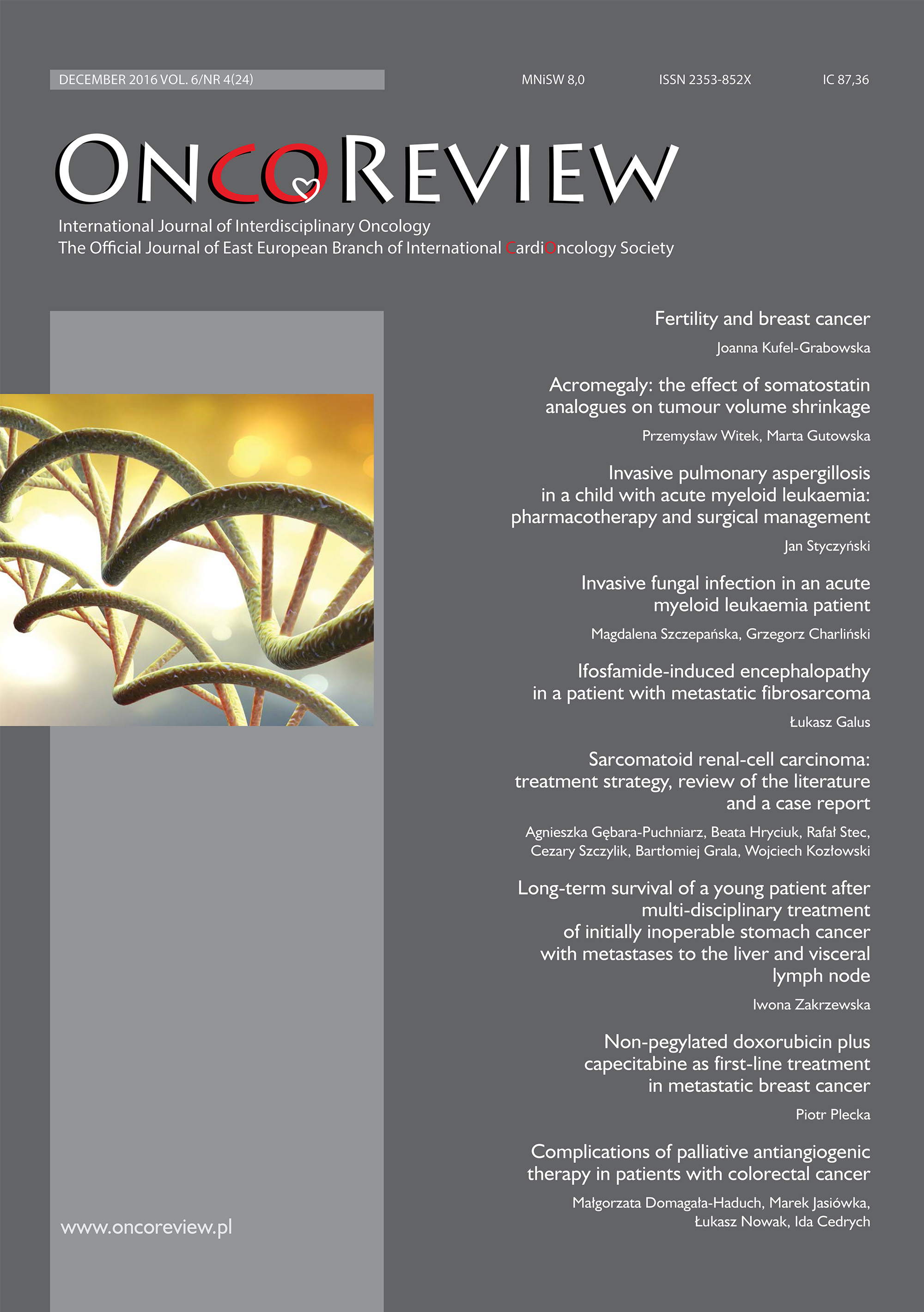Płodność u chorych z rozpoznaniem raka piersi Review article
##plugins.themes.bootstrap3.article.main##
Abstrakt
Rak piersi jest najczęściej występującym nowotworem u kobiet na świecie. Chorują na niego głównie kobiety starsze > 60. r.ż., rzadko stwierdza się raka piersi u kobiet młodych < 40. r.ż. (6,5%) i u kobiet bardzo młodych < 35. r.ż. (0,6%). U młodych chorych z rozpoznaniem raka piersi musimy zmierzyć się z dodatkowym problemem, jakim jest płodność i wszystkie jej aspekty. Stanowi to niemałe wyzwanie dla onkologa, który już przed leczeniem powinien zaproponować chorej skuteczną metodę antykoncepcji, niezbędną w trakcie całej terapii przeciwnowotworowej, a także zapewnić jej takie leczenie przeciwnowotworowe, które w jak najmniejszym zakresie będzie zmniejszało jej możliwości rozrodu. Natomiast w przypadku raka piersi związanego z ciążą lekarz prowadzący leczenie powinien zastosować terapię bezpieczną zarówno dla matki, jaki i dla płodu. Chemioterapia, radioterapia, hormonoterapia, immunoterapia mogą w mniejszym lub większym stopniu uszkadzać funkcję jajników, powodując u kobiet < 50. r.ż. zatrzymanie miesiączki od 33% do 76%, jednak dzięki zastosowaniu technik zachowania płodności i wspomaganego rozrodu coraz więcej ciąż kończy się sukcesem, nawet u pacjentek leczonych wcześniej z powodu raka piersi.
Pobrania
##plugins.generic.paperbuzz.metrics##
##plugins.themes.bootstrap3.article.details##

Utwór dostępny jest na licencji Creative Commons Uznanie autorstwa – Użycie niekomercyjne 4.0 Międzynarodowe.
Copyright: © Medical Education sp. z o.o. This is an Open Access article distributed under the terms of the Attribution-NonCommercial 4.0 International (CC BY-NC 4.0). License (https://creativecommons.org/licenses/by-nc/4.0/), allowing third parties to copy and redistribute the material in any medium or format and to remix, transform, and build upon the material, provided the original work is properly cited and states its license.
Address reprint requests to: Medical Education, Marcin Kuźma (marcin.kuzma@mededu.pl)
Bibliografia
2. Azim HA Jr, Partridge AH. Biology of breast cancer in young women. Breast Cancer Res 2014; 16: 427.
3. Azim HA Jr, Michiels S, Bedard PL et al. Elucidating prognosis and biology of breast cancer arising in young women using gene expression profiling. Clin Cancer Res 2012; 18: 1341.
4. Azim HA Jr, Santoro L, Pavlidis N et al. Safety of pregnancy following breast cancer diagnosis: a meta-analysis of 14 studies. Eur J Cancer 2011; 47: 74-83.
5. Bawle EV, Conard JV, Weiss L. Adult and two children with foetal methotrexate syndrome. Teratology 1998; 57: 51-55.
6. Turchi JJ, Villasis C. Anthracyclines in the treatment of malignancy in pregnancy. Cancer 1988; 61: 435-440.
7. McGrath S, Ring A. Chemotherapy for breast cancer in pregnancy: evidence and guidance for oncologists. Ther Adv Med Oncol 2011; 3: 73-83.
8. Azim HA Jr, Peccatori FA, Scarfone G et al. Anthracyclines for gestational breast cancer: course and outcome of pregnancy. Ann Oncol 2008; 19: 1511-1512.
9. Braems G, Denys H, De Wever O et al. Use of tamoxifen before and during pregnancy. Oncol 2011; 16: 1547-1551.
10. Sonmezer M, Oktay K. Fertility preservation in young women undergoing breast cancer therapy. Oncol 2006; 11: 422-434.
11. Patterson JS, Settatree RS, Adam HK, Kemp JV. Serum concentrations of tamoxifen and major metabolite during long-term nolvadex therapy, correlated with clinical response. Eur J Cancer Suppl 1980; 1: 89-92.
12. Clark S.: Prophylactic tamoxifen. Lancet 1993; 342: 168.
13. Online: http://leki.urpl.gov.pl/files/14_TamoxifenEbewe.pdf .
14. Thuy V, Claret FX. Trastuzumab: Updated Mechanisms of Action and Resistance in Breast Cancer. Front Oncol 2012; 2: 62.
15. Beale JMA, Tuohy J, McDowell SJ. Herceptin (trastuzumab) therapy in a twin pregnancy with associated oligohydramnios. Am J Obst Gynecol 2009; 201: 13-14.
16. Bader AA, Schlembach D, Tamussino KF et al. Anhydramnios associated with administration of trastuzumab and paclitaxel for metastatic breast cancer during pregnancy. Lancet Oncol 2007; 8: 79-81.
17. Weber-Schoendorfer C, Schaefer C. Trastuzumab exposure during pregnancy. Reprod Toxicol 2008; 25: 390-391.
18. Azim HA, Peccatori FA, Liptrott SJ et al. Breast cancer and pregnancy: how safe is trastuzumab? Clin Oncol 2009; 6: 367-370.
19. Pant S, Landon MB, Blumenfeld M et al.: Treatment of breast cancer with trastuzumab during pregnancy. J Clin Oncol 2008; 26: 1567-1569.
20. Society of Family Planning: Cancer and contraception. Clinical Guidelines. Contraception 2012; 86: 191-198.
21. Stensheim H, Cvancarova M, Møller B, Fosså SD. Pregnancy after adolescent and adult cancer: a population based matched cohort study. Int J Cancer 2011; 129: 1225-1236.
22. Roberts JE, Oktay K. Fertility preservation: a comprehensive approach to the young women with cancer. J Natl Cancer Inst Monogr 2005; 34: 57-59.
23. Lutchman SK., Muttukrishna S, Stein RC et al. Predictors of ovarian reserve in young women with breast cancer. Br J Cancer 2007; 96: 1808-1816.
24. Azim AA, Costantini-Ferrando M, Oktay K. Safety of fertility preservation by ovarian stimulation with letrozole and gonadotropins in patients with breast cancer: a prospective controlled study. J Clin Oncol 2008; 26: 2630-2635.
25. Andersen CY. Success and challenges in fertility preservation after ovarian tissue grafting. Lancet 2015; 385: 1947-1948.
26. Kim SS, Klemp J, Fabian C. Breast cancer and fertility preservation. Fertil Steril 2011; 95: 1535-1543.
27. Moore HC, Unger JM, Phillips KA et al. Goserelin for ovarian protection during breast cancer adjuvant chemotherapy. N Engl J Med 2015; 372: 923-932.
28. Burstein HJ, Temin S, Anderson H et al. Adjuvant endocrine therapy for women with hormone receptor positive breast cancer: American Society of Clinical Oncology clinical practice guideline focused update. J Clin Oncol 2014; 32: 2255-2269.
29. Pregnancy outcome and safety of interrupting therapy for women with endocrine responsive breast cancer (POSITIVE). Online: http://www.clinicaltrials.gov.
30. Surveillance, Epidemiology, and End Results Program. Online: http://seer.cancer.gov.

